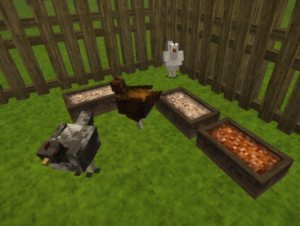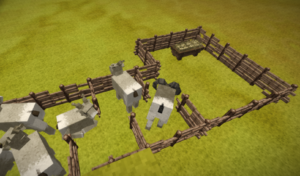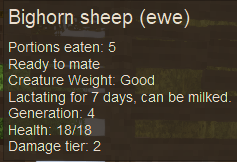Animal husbandry/de: Difference between revisions
(Übersetzung) |
(Übersetzung) |
||
| Line 25: | Line 25: | ||
==Umsiedeln von Tieren== | ==Umsiedeln von Tieren== | ||
Bis einschließlich Version 1.4 beinhaltet das Spiel keine Leinen oder Ähnliches, um wilde Tiere einfach zu fangen oder bereits gezähmte Tiere umzusiedeln | |||
===Capturing Wild Animals=== | ===Capturing Wild Animals=== | ||
Revision as of 16:33, 12 May 2022
Zähmung ist der Weg, um Tieren im Laufe der Generationen die Furcht und Aggressivität dem Spieler gegenüber zu nehmen.
Vintage Story beinhaltet Spielmechaniken, die das Zähmen einiger Tiere, die die Welt durchstreifen, ermöglicht. Um Tiere zu zähmen, müssen Spieler mindestens ein Männchen und ein Weibchen fangen, damit Nachkommen in einer Gegend geboren werden können, in der sie von Raubtieren weder gejagt noch getötet werden können. Das Verhalten der Tiere verändert sich nach einigen Generationen. Du kannst weder Aggression noch Furcht eines bestimmten Tieres beeinflussen, nur dessen Nachkommen werden weniger ängstlich und aggressiv dem Spieler gegenüber sein. Auch nach vielen Generationen werden Wildschweine und Dickhornschafe noch immer aggressiv, wenn sie angegriffen werden.
Generationenwechsel
Nur das Muttererbe ist relevant, der Vater spielt für die Generation der Neugeborenen keine Rolle. Das bedeutet, dass bei einem Weibchen der 3. Generation und einem Männchen der 4. Generation immer Nachkommen der 4. Generationen entstehen, da die Nachkommen immer eine Generation über der Mutter sein werden.
- Nach 3 Generationen:
- Tiere können fast augenblicklich mit dem Hackebeil getötet werden.
- Nach 10 Generationen:
- Schlafende Tiere wachen nicht mehr auf, wenn sich ein Spieler nähert.
- Aggressive Tiere verhalten sich neutral und greifen z.B. nur an, wenn sie provoziert werden.
- Tiere laufen nicht mehr vor dem Spieler davon.
Zu Testzwecken gab es in Version 1.14 einen Befehl, mit dem der Spieler die Generation des Tierbestandes verändern konnte:
/debug setgen [number] - wobei die Nummer für die gewünschte Generation steht.
Umsiedeln von Tieren
Bis einschließlich Version 1.4 beinhaltet das Spiel keine Leinen oder Ähnliches, um wilde Tiere einfach zu fangen oder bereits gezähmte Tiere umzusiedeln
Capturing Wild Animals
For capturing wild animals, two different methods can be employed:
- Active: Provoke the wild boars/pigs or bighorn sheep with a weak attack. In return, boars and sheep will try to attack players. If players run away from them, they will follow for a short distance. This behavior can be used to guide them into carefully prepared animal pens. Female pigs and sheep will always follow their male counterpart. If you encounter a group of animals together, try only antagonizing the males - the females will automatically follow. Wild chickens always try to flee from the player, again, use this advantage by chasing the chickens into the pen.
- Passive: In an area nearby the animals to capture, dig a pit at least 2 blocks deep and place a trough with food portions in it. Wait for the animals to fall into the pit trap, and convert the pit into the animal pen. Players can also chase wild chickens into this pit trap.
Moving Domesticated Animals
Moving animals around can be complicated after the player has already started breeding them, as animals will loose their fear of the player after generation 10, and might not easily run away or be provoked to attack and follow.
Therefore, as an alternative to the above mentioned methods, a funnelling technique can be employed to move animals or even separate them if need be, for instance to cull lower generations.
To archive this, the player needs at least one trough, plenty of fence and the appropriate food for the animals. Then simply build a corridor from the original enclosure to the next one (or an in between stop). Place a filled trough in the new enclosure, and open the corridor on both ends. Make sure you are in a good position to place fences in the corridor as need be.
The animals will start walking from the original enclosure towards the filled trough, and the player should have enough time and space to place fences to separate the animals from each other. Depending on where the trough is placed, the walking direction of the animals can be influenced to give the player even more opportunity to intervene and pull animals out of the herd.
Another useful moving technique is water. Be careful, water also lifts animals up, so they can climb fences of single height.
Breeding
All animals must consume portions of feed in order to breed.
Placing 8 dry grass or 2 grain into a trough players can feed animals. Both male and female animals must eat until they become saturated. The Block info HUD shows the level of saturation when a player looks at an animal. It will also show the creature weight, generation, whether an animal is ready to breed, to milking and if it may disappear due to darkness.
Animals can consume food from 0.6 blocks away and mate at a distance of up to 10 blocks away.
Males don't show their saturation, but they need a saturation value of at least 1.0 to mate. Since their satiation slowly goes down, in average they need to eat at least twice (food portion gives 1.0 satiation), to be able to mate with a female. After mating, the male animal lose 1.0 satiation and the female loses up to 10 saturation, depending on the type of animal.
Pigs
Boars eat animal feed placed in a large trough. The Sows will need a satiety value of 10 before they are ready to mate. After a pregnancy of 25 ingame days, sows bear litters of multiple piglets (4-6) at a time, so be sure the pen is large enough to accommodate for a "pigsplosion", which may occur when breeding multiple females simultaneously. Piglets will need 158 hours to grow up, with a chance of 75% to be female and 25% to be male. Sows will have 6-11 days of "cooldown" time before they can breed again.
Note that boars (and sometimes sows) will attack players when in close range but will become passive after 10 generations.
Sheep
Sheep eat animal feed placed in a large trough. Troughs hold portions of dry grass or grains and sheep will consume either grass or grain. The Ewes will need a satiety value of 10 before they are willing to mate. After a pregnancy time of 20 days, ewes bear one lamb at a time, chances for male or female are 50/50. Lambs will take 336 hours to grow up, and the Ewes will need 4-11 days break before they are ready to breed again.
Note that male sheep (and sometimes the females) always attack players when in close range, but they will stop doing so after 10 generations of breeding.
Chickens
Chickens will only eat grain placed in small troughs. Hens need to reach a satiety of 6 before they are ready to mate. For now, baby chicks are not preceded by eggs - they appear like other baby animals. The pregnancy takes 9 days for the hen and there will be 1-2 chicks, with a "cooldown" of 6-9 days before the next pregnancy. The chicks will grow up after 168 hours, with a 90% chance for more hens and only a 10% chance for a new rooster.
Hens will lay eggs on the ground every 8-15 in-game days, which can be used in cooked foods but do not have any impact on breeding new chickens. Players should collect the eggs regularly, as they disappear within 2 days.
Harvesting and Butchering
Harvesting
Domesticated and/or wild animals can be killed and harvested for meat, raw hides, bones, and fat.
- In order to harvest, a player must Shift+right click with a Knife in hand to harvest or butcher animals.
- Note: The amount of items acquire by this method depends on the Weight Condition of the animal.
Milking
Ewes lactate for 21 days after giving birth. When hovering over an ewe, if tooltips are enabled, it will indicate if it's lactating. Ewes will indicate lactating regardless of generation. However, the milking process might vary:
- Generation 0 and 1: If you hold right click while carrying a bucket, you risk distressing the ewe too much that it won't provide milk for the rest of the day. The best way to do it involves holding right click up until the ewe feels distresses enough to reject your bucket. At that point, you must release right click and wait a couple seconds until the ewe relaxes itself. Repeat this process until the bucket stays long enough for you to properly milk the animal.
- Generation 2 and above: Ewes can be milked easily by just holding right click while holding a bucket, however there remains a 5% chance for them to become distressed even at this and all following levels of domestication.
- Note: Ewes cannot be milked every day, despite lactating. This can be checked by reading the tooltip.
The milk can either be consumed directly when taken from the bucket with a bowl, or used in a barrel to make Cheese.
Creature Weight and Darkness
Two parts of husbandry that may be confusing for new players are the creature weight and darkness mechanics.
Creature Weight
The Block info HUD shows a property called "Creature Weight" which can range from good, decent, low, and starving. A lower creature weight causes fewer items to be dropped when it is killed. This is an issue over winter, or in cold areas, as it can significantly reduce the yield of livestock. Keeping animals well-fed prevents their weight from decreasing.
Darkness
Many animals will disappear if they are in darkness for too long and players can see if animals will disappear by looking at the Block info HUD. Light sources like oil lamps or lanterns, as well as sunlight, can prevent animals from disappearing. This is the only way for animals to despawn without being killed.
Other animals
Bienen können nicht domestiziert werden, aber die Technik der Imkerei kann dazu beitragen, sie in eine "kontrollierte Umgebung" zu bringen, um ihre Erzeugnisse ernten können, ohne sie alle getötet müssen.
Füchs, Hasen, Hyänen, Waschbären, Wölfe, Drifter und Spinnen können nicht domestiziert werden und müssen gefangen und/oder gejagt werden, um die Früchte ihrer toten Körper zu ernten.
Füchse, Hasen, Hyänen, Waschbären und Wölfe können wegen ihres Fleisches, Fett, ihrer Felle und Knochen gejagt werden. Durch die Jagd auf Drifter erhält man Flachs, rostige Zahnräder und temporale Ausrüstung. Spinnen haben jedoch keine Beute, so dass sie nur eine Ablenkung zum Ernten darstellen.
Video Tutorials
| Ausführliche Erläuterung der Tierzucht, Version 1.16 |
|---|
| {{{title}}} | |
|---|---|


